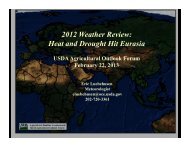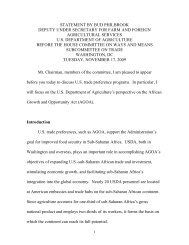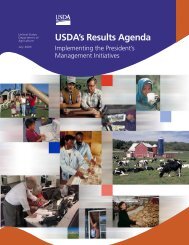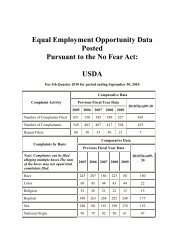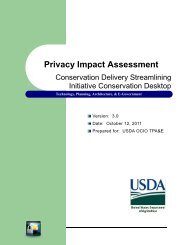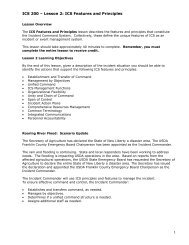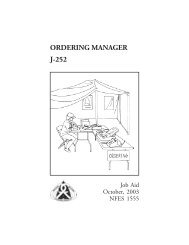USDA 2007 Farm Bill Proposals - US Department of Agriculture
USDA 2007 Farm Bill Proposals - US Department of Agriculture
USDA 2007 Farm Bill Proposals - US Department of Agriculture
You also want an ePaper? Increase the reach of your titles
YUMPU automatically turns print PDFs into web optimized ePapers that Google loves.
have driven implementation <strong>of</strong> systems before they have been thoroughly tested. As aresult, computer systems have generated overissuances because <strong>of</strong> design flaws; in somecases, the courts have become involved (e.g. Colorado) and judges have ordered Statesnot to collect overissuances from recipients when the overissuance was an agency error(computer generated) and not a client error. However, current Federal law requires Statesto establish and collect claims from recipients. This proposal would recognize the uniquesituation <strong>of</strong> systemic errors caused by State agencies in the establishment and collection<strong>of</strong> over-issuances while still holding States responsible for the error.BackgroundAuthorized by the Food Stamp Act <strong>of</strong> 1977 (the Act), the Food Stamp Program (FSP) is thecornerstone <strong>of</strong> the Nation’s nutrition assistance programs which serve 1 in 5 Americans. Duringfiscal year (FY) 2005, the Program served approximately 26 million people in an average monthwith a total annual benefit cost <strong>of</strong> approximately $29 billion. The FSP increases the purchasingpower <strong>of</strong> low-income families and individuals by providing electronic benefits redeemed forfood in authorized stores.The program operates in partnership with the States. The Federal Government sets nationalprogram standards for eligibility and benefits, funds all benefit costs and approximately half <strong>of</strong>State administrative expenses, and has responsibility for monitoring and oversight <strong>of</strong> programimplementation, including authorization and enforcement measures associated with theredemption <strong>of</strong> benefits at authorized retail stores. State agencies interact directly with programparticipants, are responsible for eligibility certification.Outreach to underserved populations and program integrity have been a primary focus for theAdministration. At the same time that there has been an increase in participation, programintegrity has also improved. In FY 2005, the FSP reached the highest level <strong>of</strong> payment accuracyin its history <strong>of</strong> 94.16 percent. The Food Stamp Program has a Quality Control System that usesa statistically valid sample <strong>of</strong> State cases to determine the accuracy <strong>of</strong> food stamp benefits andestablish a national error rate. The Program has also seen progress in the area <strong>of</strong> trafficking(exchanging benefits intended for food purchases for cash), with a recent GAO report stating thattrafficking has been reduced to 1 cent <strong>of</strong> every benefit dollar, down from almost 4 cents.The purpose <strong>of</strong> the FSP is to increase the nutritional levels <strong>of</strong> low-income households whoqualify based on criteria associated with income, assets, and household composition. To qualifyfor benefits the applicant’s gross income must be less than 130 percent <strong>of</strong> poverty (e.g., $2043per month for a family <strong>of</strong> four in 2005), and 100 percent after allowable deductions. Themaximum monthly food stamp allotment ($499 for a family <strong>of</strong> four in 2005) is based on the cost<strong>of</strong> the Thrifty Food Plan, a low-cost nutritious model food plan. The Program also providesnutrition education designed to help low-income individuals choose healthy foods and activelifestyles.<strong><strong>US</strong>DA</strong> <strong>2007</strong> <strong>Farm</strong> <strong>Bill</strong> <strong>Proposals</strong> Page 91 <strong>of</strong> 183




